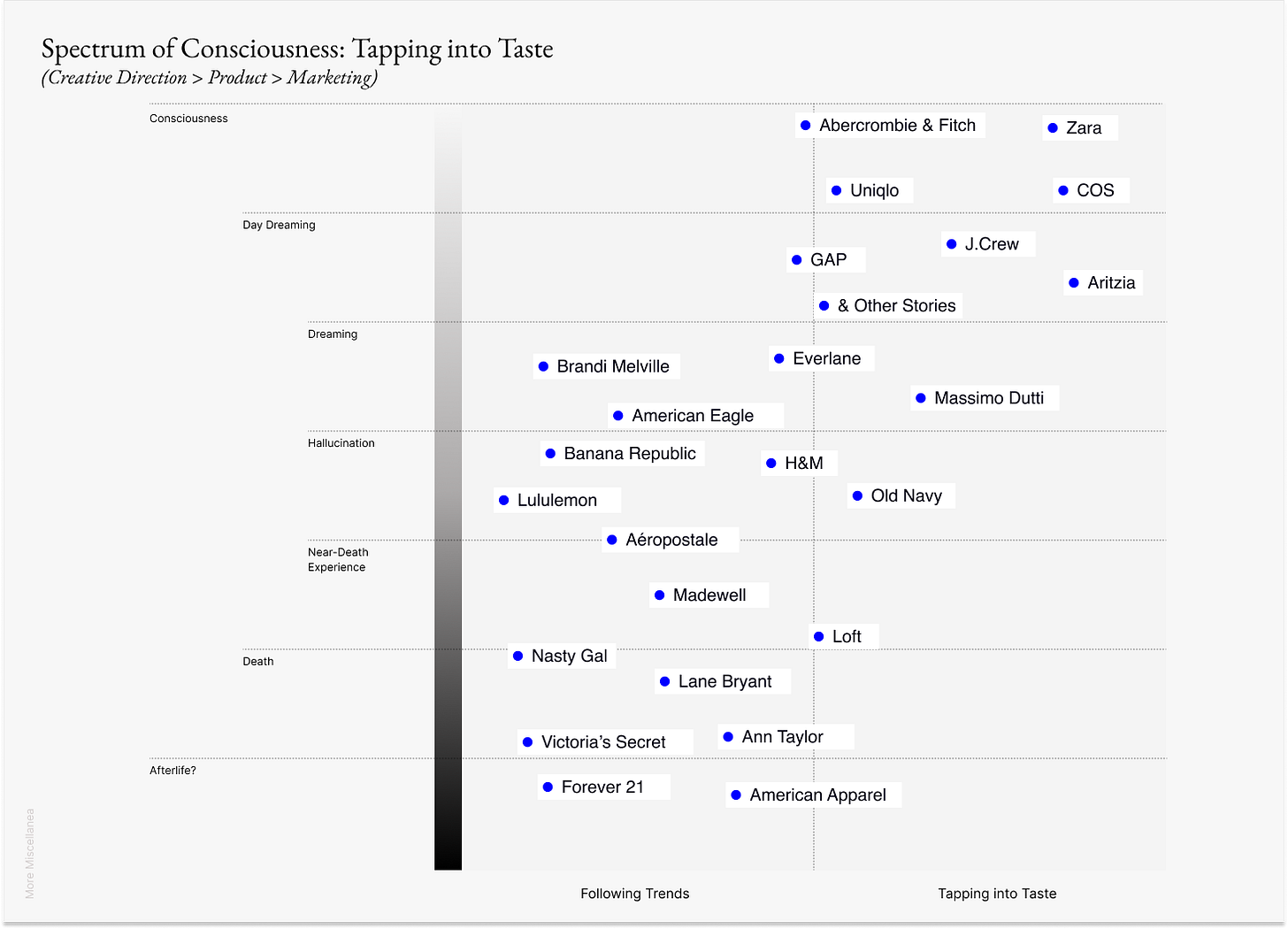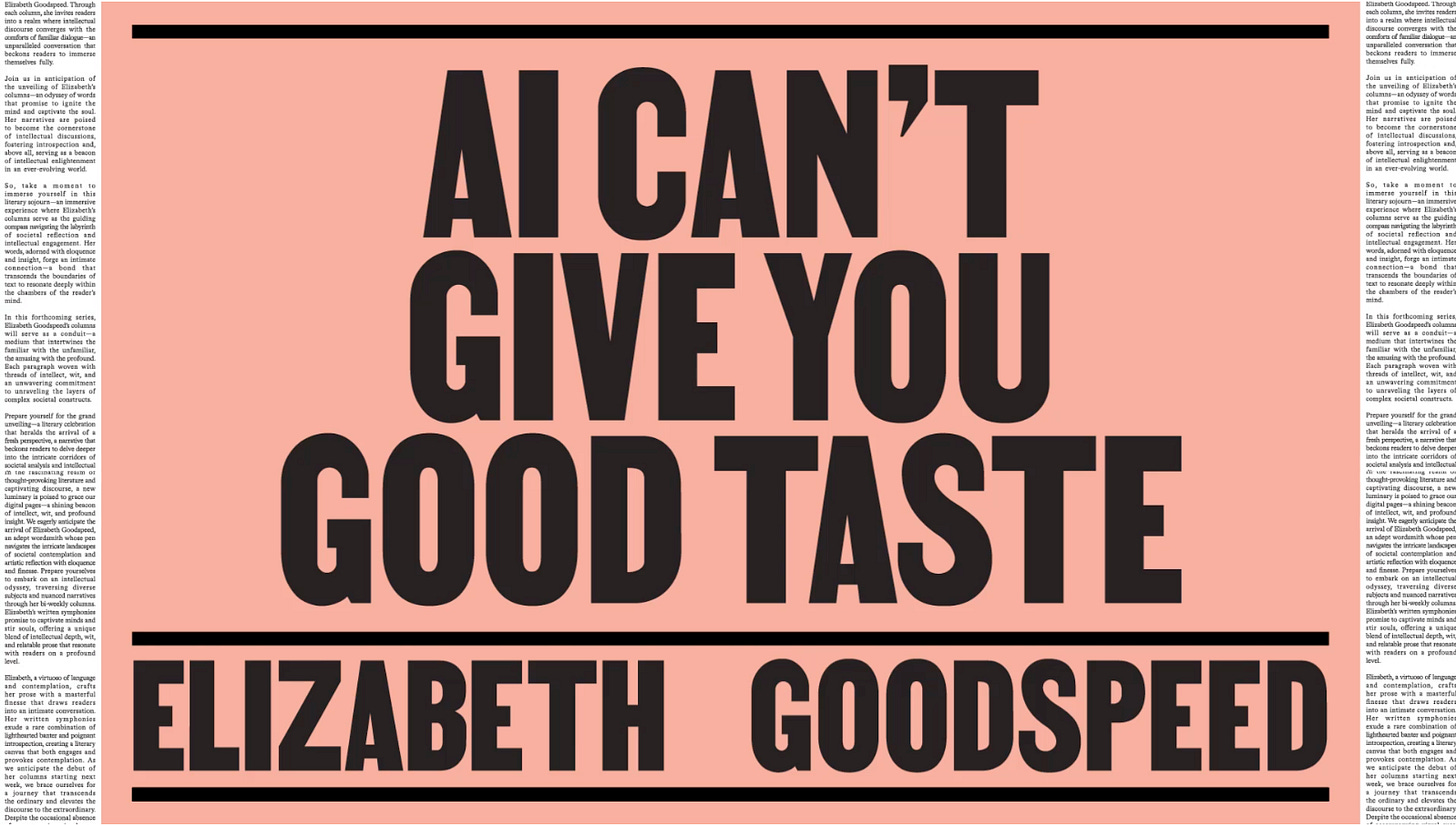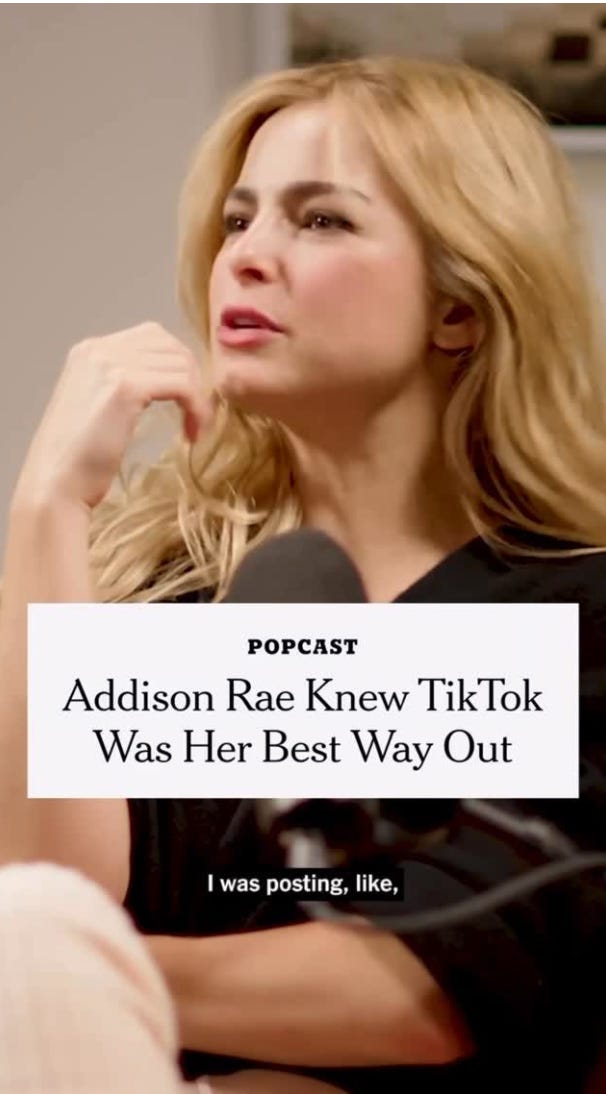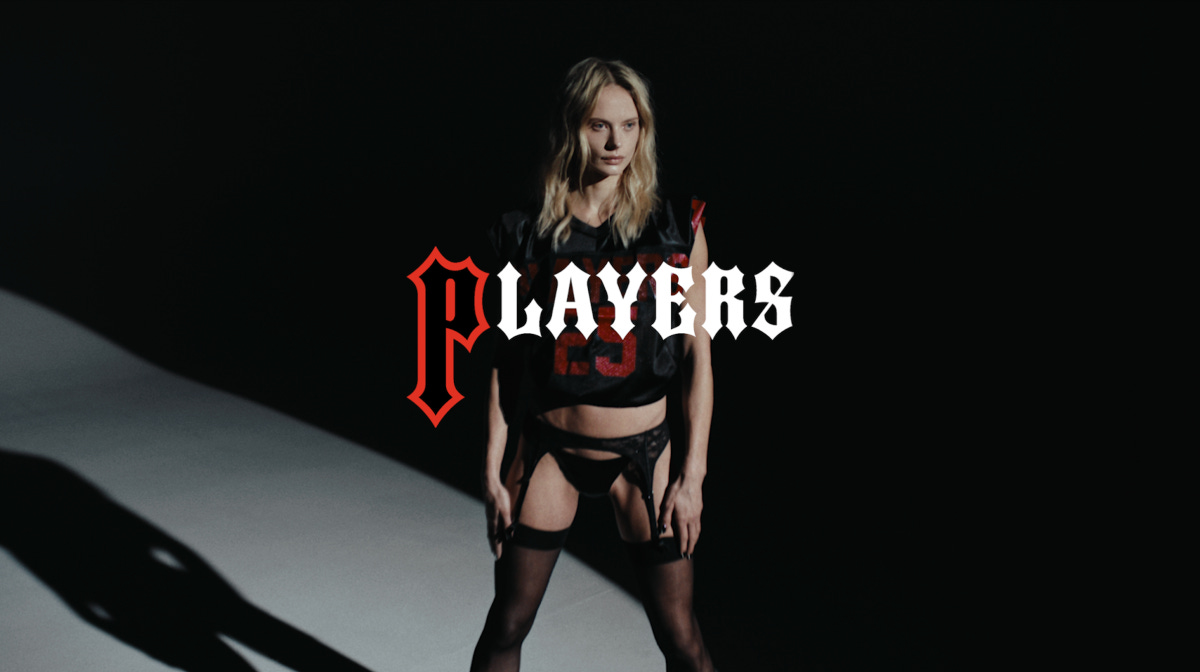The Unnecessary Pressure of 'Taste' Forecasting
Taste is longed for as something to own (ours), to judge in others (influencers, brands), and as an authenticator (moodboards to a.i.). Taste is something to trust, but today it's a test.
Taste is our ‘avoidant-attachment’ industry word of the month.

It goes hand-in-hand with the general preference of the word 'style' this year so far, which might not feel like much of a difference, but implies a more tangible action to the looser use of 'aesthetic' these past 5 years. Working to impact 'personal style' has been a sigh of relief for design teams whose work has been whittled down into non-sensical '-cores' and engagement metrics over brand loyalty (via sales) for far too long. Our audiences are seemingly tired too, with style a welcome term to tap into a point of personalization, the antithesis to algorithmic trends, intended to be #ForYou or not. At the same time, the emerging use of taste as a way to filter a.i. slop and referential creativity omits the thing that we're really seeking: design and originality.
The key words and language of our work have been top of mind these past 6 months, as artificial intelligence, 'aesthetic intelligence' (Pauline Brown, 2019), and authentic intelligence became core to online chatter, deep dives and podcasts. Add to the mix 'culture', 'authenticity', 'luxury' - brand and marketing buzzwords that dilute the purpose of our work, and eventually fade into obscurity against a competitive market of similar promises and products. The business of branding and marketing, the louder part of our work, has blurred much of what we buy into. Zara is authentically fast. Louis Vuitton is not culture. Everlane is not value. An Erewhon smoothie is expensive, not a luxury.
I say 'our work' to recognize that we are creative professionals who translate consumer and market insights into products, messages, and experiences for our audiences. And what of our work when our markets are audiences-first - consumers of social media content and (usually infantilized) marketing speak that meets them on their algorithm? When consumers crave taste validation to feel some agency, has 'taste' simply become their filter for endless options?

This week, I explore how taste, and the whirlwind of chatter around it has trickled into the world of TasteMaxxers. Taste as Concept → Taste in Practice:
↓ Start | + Chain of miscellanea | ✳︎ Finish
↓ Since the tech industry and its reporters first discussed 'taste' early last year, the topic has reached fashion media and commenters. A mostly binary idea (good taste vs bad taste) is no more - users of the word are treating it more as a catchall for everything to do with choice and perspective, interchangeable with style and (thankfully) 'vibe' for e.g. a moodboard of 'taste' > a mood board of 'vibes', and is quickly embraced by many as it alludes to a point of ownership, rather than something that you express casually (aesthetics) or seriously (personal style) or succumbed to (micro-trends).
+ Taste in tech is generally being discussed as a way to distinguish bad software and good software in a time of app abundance, mostly enabled by vibe-coding and a.i. My argument here is that it's not the distinction of taste, it's about trust and investment in graphic designers and UX designers which executives seem to not value appropriate to their goal of being, well, tasteful. This attitude toward designers is also prevalent in the fashion industry.
+ A lack of trust in design and its processes is what's causing many businesses to fail. To have good taste is not always the sum of good design. Good design mostly comes from making sense.
+ Similarly, with an abundance of fashion brands, taste - as something you have and something you tag - is becoming used as an identifier of good or bad, blindly playing into historical uses of the word that mostly had to do with class and race (Outdated, but still some relevance, see: 'A Social Critique of the Judgement of Taste', Pierre Bourdieu, 1979)
+ Taste is discussed in a binary manner, which often results in being exclusionary.

+ Taste implies a point of judgement.
+ We could maybe use it interchangeably with 'interest', in the way
called it 'Our Collective Taste': our collective interest or from our collective judgement. It signals an appetite for xyz, or an emerging, existing, and building palette for a specific style, so to speak.+ Taste emerges from tension. To be acknowledged as 'having taste' requires a christening from another.
+ When we're focused on vibe-coding, tastemaking, curating, hacking, and duping examples of taste, doing the work for innovation - or originality - is not enticing.
+ "There is no time to be original, as it would take years dedicated to learning, assimilating to a philosophy and eventually diverging from your previous paradigm in order to carve out your own. There is no time to study an art form, to submerge yourself in an archive; the search engine has eroded our skills at scavenging for information, through discographies, galleries, or libraries. Thus the part of the journey usually dedicated to development, intentional consumption and tangible engagement has been erased to make space and time for more aimless output.” – from The Cost of Convenience,
, December 2024+ Taste cannot be proven to be authentic, and authentic doesn't mean much anymore when being artificial - or at least an integrated artificial - is so easy, and maybe even expected.

+ Today's youth suggest a different path than their older siblings' rite of passage of discovering taste through process - thrifting, building MySpace pages, Limewire downloads, endless pages of Bloglovin' Streetstyle blogs, Polyore moodboards and fashion forums. They can instead instantly discover taste-time-capsules on TikTok, Amazon to Pinterest - pre-packaged and pre-validated by algorithms and creators.
+ If the crux of Millennials was that they were raised to feel special while graduating into a recession dressed in hipster-yuppie-casual and a DTC-minimalism, Gen-Z's is that they were raised as unique while digitally native to algorithms, therefore more inclined to seek ownership and some sort of independence more than their counterparts.
+ What's interesting between the two gens is that a 'taste freeze' in music (and I'd argue much more re: nostalgia) is prevalent across every gen except Gen-Z, who are digitally native and discovered music on Spotify and TikTok music trends

+ Design is not universally understood (nor practiced) but is more valuable than taste
+ Separating designing for culture and designing for lifestyles is what results in better design, and both are regardless of taste, good or bad. Usually designing for lifestyles is more successful re: controversial rebrands, which ultimately succeed or fail based on whether their designs make sense for the lifestyle they're targeting.

+ The work of design, or its merchandising, styling and presentation, does not depend on expressions of taste and style. It relies on the study of a Greater Thing, and the foresight to determine what it is that we want to say, not just how it looks or tastes. Why go through the trouble of recreating a cultural memory when it doesn't leave us craving for the delicacy pictured?
+ "The problem is one of content. The misconception is that without deep content, design is reduced to pure style, a bag of dubious tricks. In graphic-design circles, form-follows-function is reconfigured as form-follows-content. If content is the source of form, always preceding it and imbuing it with meaning, form without content (as if that were even possible) is some kind of empty shell." – Fuck Content, Michael Rock at 2x4, 2009
+ This search to acquire taste by Silicon Valley is proof that designers have not been able to design with conviction in the past 10 years. It rings true for designers in fashion as well, with heads of beloved brands being more scrutinized online at surface level discussions around taste and concept over the work of design.
+ Social Media and the economics of creating for metrics built on 'likes' have created a bottleneck industry, widening the collaborative gap between directors and marketing with the designers and buyers who create and select the products for which we all gather at the table.
+ Taste-making and vibe-building should only be 25% of the process at most but it's becoming a priority for social-first marketing. Think big marketing moments with zero follow through, or glorified merch brands with amazing brand IP that results in too many SKU's and not enough design distinction from competitors.
+ It's disheartening how a call to end all gatekeepers (of taste) and a democratization of fashion has resulted in a monoculture mess.
+ What we really need are more editors.
+ We've become so enamored with buzzwords, headlines, carousels of infographics (myself included) that we have forgotten about the importance of editing, the original process of authenticating information, to some degree
+ We're pivoting from trusting numbers and click-bait data declarations to points of 'taste', when taste economies or spotlighting tastemakers are not sustainable modes of work.
+ If everything is beautiful, nothing is. An over-saturation of taste numbs our tastebuds to crave salt (or something sweet), no matter what it looks like.
+ When there is too much taste, or talk of it, even an endless scroll of tasteful content and perspectives appear bland, as a generalization of 'good taste' becomes a baseline and not unique, disruptive, or original enough to stand out from the rest (re: conversations around chaos packaging by Michael Miraflor).
✳︎ Working in good taste has been our default system, but we've regressed into designing for validation instead of cravings.
[In case of interest: Not fashion related, but the most terrible example of this I’ve come across so far in tech, is LooksMapping, reported as an ‘a.i. powered app that rates restaurants based on the attractiveness of their diners’ by The New York Times. ]
All billing for paid subscribers have been paused until August, or at the very least, until I hit 'post' on my backlog of work. Thanks for your continued support. Would love to hear from you, feel free to reach out.




